Simulation of molecular motion (Brownian, diffusion, etc.) with ball bearings on shaking table.
What it shows:
Two dimensional simulations of molecular dynamics and crystal structure using ball bearings. It can be used to show qualitatively the dynamics of liquids and gases, and illustrate crystalline forms and dislocations.
How it works:
The molecular dynamics simulator is more commonly known as a shaking table. It consists primarily of a circular shallow walled glass table that is oscillated vertically so as to vibrate and shake the objects (usually ball bearings) sitting on it. The table is driven by adapted speaker cones attached to a lower base table (figure 1). Construction details of a homemade shaking table are given in Additional Comments. The main operational difference between the two is that the commercial unit is driven with 60Hz mains through a Variac so is limited to amplitude variations. The homemade table is driven by a function generator so you have amplitude and frequency control (see Setting it Up). figure 1. The shaking table. Illustrated is the "homemade" version, which differs a little in shaking plate support and base plate shape from the commercial model.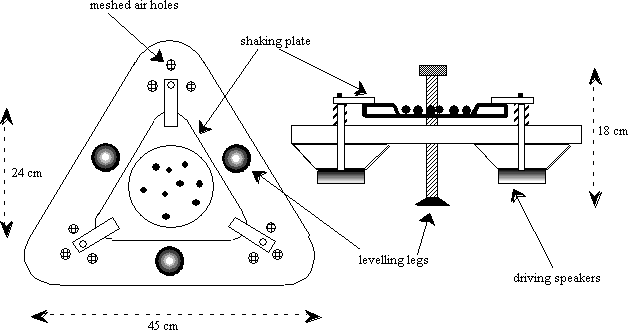
The shaking table can be used to demonstrate a wide variety of molecular and crystalline scenarios. Here is a list of those most commonly used at Harvard.
SOLID → LIQUID → GAS TRANSITIONS: These transitions are best demonstrated by gradually increasing the number of spheres (i.e. increasing the density). The liquid → gas transition is a gradual one (hence the possibility of a critical point), from predominantly forward scattering upon collision (gas) to primarily back scattering (liquid). The liquid → crystal transition is observed by the emergence of the characteristic hexagonal close-packed patches. Changing the vibration amplitude (in rough analogy to changing the temperature) is not satisfactory on the commercial table since only a very narrow range of amplitudes is usable. However, changing the frequency from off-resonance to on-resonance (16 Hz) on the homemade table works quite well. An inverted petri dish is needed as a cover in this case (attach using modeling clay) because the gas tends to 'evaporate'.
ATOMIC DIFFUSION MEDIATED BY VACANCIES: Create a vacancy in a crystalline layer (using tweezers). The vacancy moves by neighboring atoms jumping into it. The rate of vacancy motion is very sensitive to the density of the crystal (that is a peculiarity of this experiment - not a correlation in real crystals). By adjusting the number of spheres, the vacancy can be made to jump once every five seconds or so. The neighboring atoms make several attempts to jump into the vacancy before one of them succeeds (that is a realistic feature).
GRAIN GROWTH: Fill the tray with a polycrystal, i.e. a number of crystals of different orientations. The boundaries between the individual crystals are known as grain boundaries. At the right overall density, atoms can jump across the boundary from one crystal to the other and make it move. Prolonged vibration leads to a decrease in the number of grains (i.e. an increase in their average size) by having some of the grains grow at the expense of their neighbors. Eventually a single crystal results.
DISLOCATION MOTION: Make a single crystal that fills most of the tray; tilting it slightly is the easiest way to do this. Using a 1-2 cm slat, push some of the spheres on the side opposite the open space towards the center of the tray. Dislocations can be seen to move to accomplish the imposed plastic deformation. By suddenly turning off the vibration, it is possible to "catch" a dislocation in place. The core of dislocations in this hard sphere system is very wide (even more so than in the Bragg bubble raft movie (see References) which is very useful to view at the same time. With some trial and error, it is possible to observe the climb of dislocations and the attendant disappearance of lattice vacancies (again the Bragg movie is the best direct example here).
NON-SPEHERICAL MOLECULES: It should be possible to simulate liquid crystals by using objects with oblong shape. We have tried rice (too round) and chopped spaghetti (too elongated). This is still being investigated.
AMORPHOUS MATERIALS (GLASSES): An amorphous phase (i.e. a solid, non-crystalline phase) can be created by mixing spheres of two sizes. The ratio is not critical; 2/3 or 3/4 works fine. In two dimensions, the two sizes are essential, since in a monatomic system the configuration for maximum short range order (triangle) coincides with that for the crystalline long range order (hexagonal). In three dimensions, this is not the case: maximum short range order is accomplished in a tetrahedral arrangement, whereas the crystal (face-centered cubic or hexagonal) requires octahedral as well as tetrahedral configurations. Grouping of just tetrahedra leads to the formation of icosahedra; the five-fold symmetry precludes crystalline periodicity.
BROWNIAN MOTION: By placing a few larger ball bearings (say 1/4", 5 mm) in with a lot of smaller ones (1/8", 2mm) you can simulate the molecular bombardment of pollen grains first observed by Brown. For a particular shaking amplitude all the balls will have the same kinetic energy so the smaller will have substantially higher velocities. In elastic collisions between small and large, the larger will jiggle with little translational motion, whereas the smaller rocket all over the place. A good companion demo for the Brownian Motion of Smoke Particles demo.
Setting it up:
The simulator needs to sit on a flat overhead projector (not tilted as most hall OHPs are). The simulator table has suction cups to prevent sliding. To level, place one or two ball bearings on the glass plate and use the leveling screws for adjustment; this is slower but more accurate than a spirit level. The commercial table is driven by mains 60 Hz AC connected through a 0-130 V Variac. For crystal demonstrations maximum amplitude shouldn't be over half a sphere diameter. The homemade table is driven by function generator 1 through a power amp 2 . The drivers should not be operated without the shaking plate attached to the driver posts.
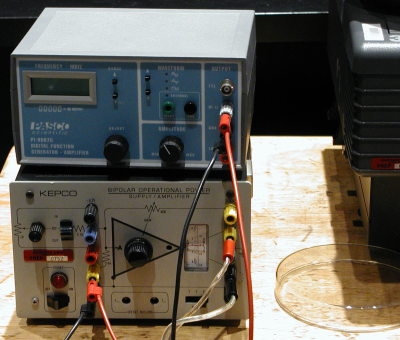
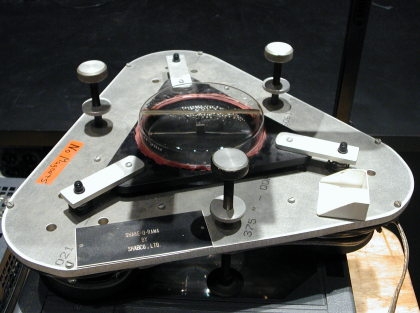
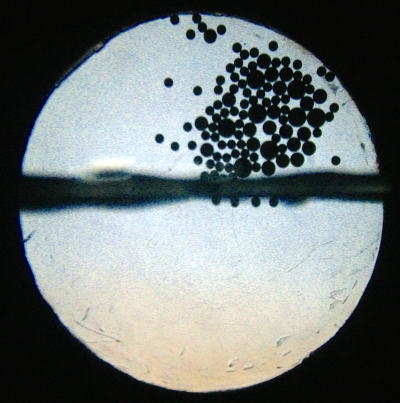
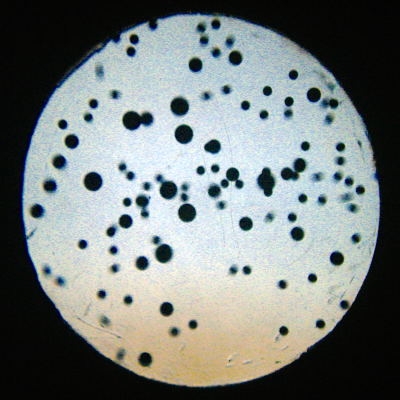
Comments:
Many thanks to Professor Frans Spaepen for his invaluable input of shaking table applications. The molecular dynamics simulator was designed by Professor David Turnbull of Harvard and Robert Cormia of General Electric. The commercial simulator was built by Holt, Rinehart and Winston Inc. 3 whose supplied handbook gives further suggestions for simulations.
It is important not use a magnet to collect the steel spheres from the tray as this magnetizes them. Use a scoop (ours is made out of card) even though it's more tedious. Electrostatic charging can also be a problem with certain spheres. Even aluminum spheres, with their strong oxide coating can charge up under the wrong conditions.
References:
L. Bragg, W. M. Lomer, J. F. Nye, Experiments with the bubble model of a metal structure, 17 minutes VHS (originally 16mm), producer N. S. Marqueen (1954)
R. C. Plumb, The Molecular Dynamics Simulator Handbook (Holt, Rinehart and Winston Inc.)
D. Turnbull, R. L. Cormia, J. Appl. Phys. 31, 674 (1960)
Additional Comments:
The commercial simulator is no longer available. However, a similar device was built in the Science Center by Brian Shaban to complement the commercial unit. Both shaking and base tables are made of 1 cm aluminum plate. Each has a 12 cm diameter center hole, open in the lower table and a 5 mm thick glass window in the upper. The walls of the molecule chamber are therefore about 5 mm high, and angled at 45°. The shaking plate is supported by three driving posts of 1.2 cm aluminum rod and attached with thumb nuts. The clearance between upper and lower table is 1 cm, the weight of the upper table is taken by 1 cm long springs around the posts. The three drivers are 5 inch Bose 6Ω speakers connected in parallel. There are four 1cm air holes for each speaker in the lower table around the driving post to alleviate pressure changes. A fine brass mesh screen covers the holes lest you should drop ball bearings down into the cones. The whole shaking table assembly is supported on three 18 cm long threaded aluminum rods. These also act as the leveling screws. Each has suction cup feet to secure the table to the OHP.
1 IEC F34 Function Generator
2 Kepco BOP 36-5M bipolar power amplifier
3 Holt, Rinehart and Winston Inc., 383 Madison Avenue, New York NY 10017